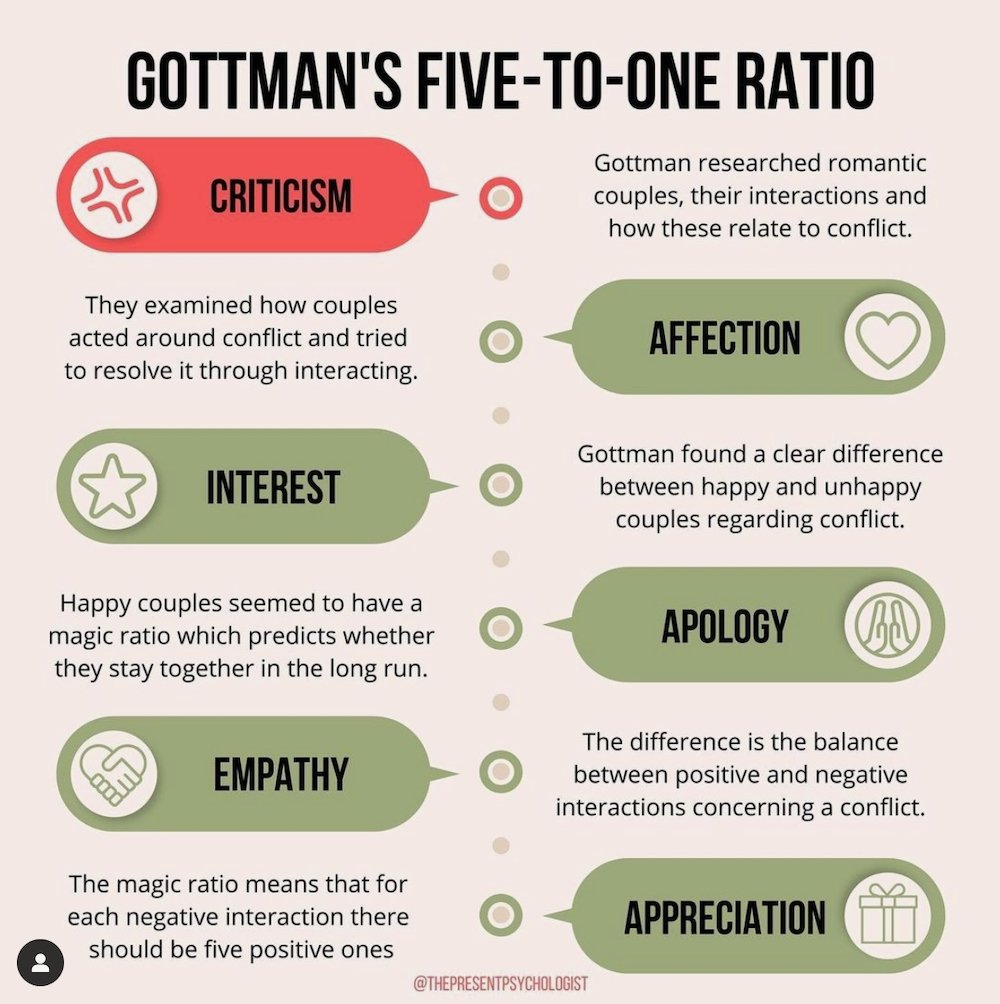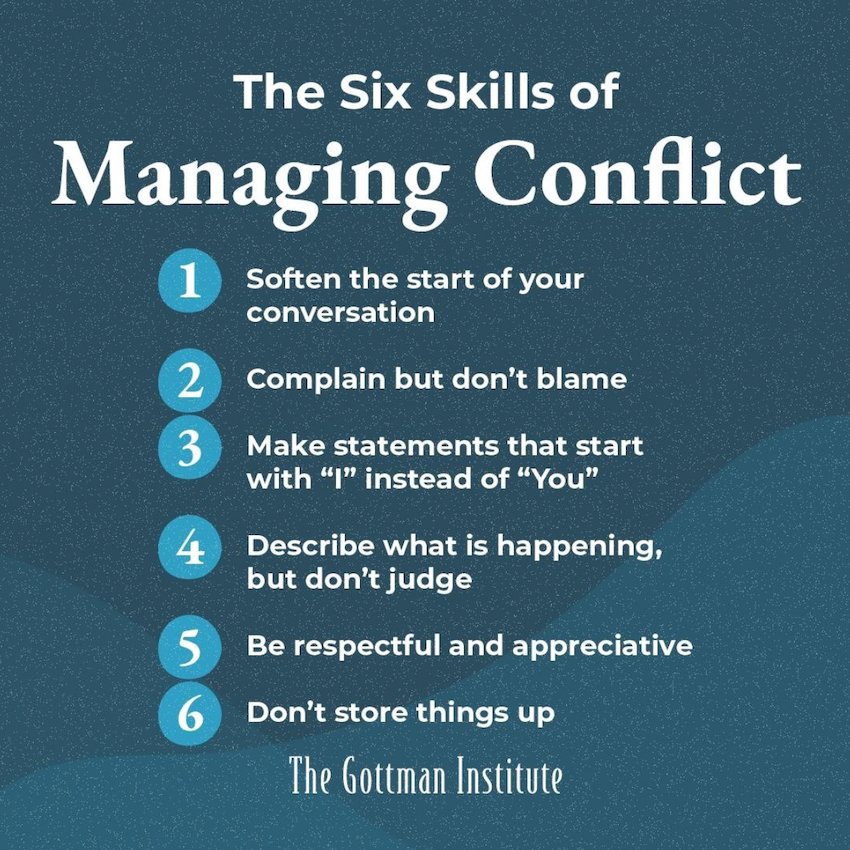A Simple Math Formula for Saving Your Relationship (Yes, Really)
by Lynn Maleh
I have a hard time buying into everyone’s “great advice.”
I’m a therapy skeptic, a fashion denier, and I have zero interest in switching to zoodles. Unless, you have some concrete numbers or hard science to back it up, I’m most likely going to take your wellness claim with a grain of Himalyan sea salt.
So when I heard there was a magic ratio, an actual mathematical formula, for creating a happier, healthier relationship, my ears perked up.
This ratio was developed by none other than psychologist and researcher Dr. John Gottman, who can predict–with 90% accuracy–whether a relationship will or won’t last. If you, like me, get chills from those kinds of hard-hitting numbers, let me introduce you to Dr. Gottman’s research-based formula for more successful relationships.
Ready for it? Here’s the Gottman formula:
1 negative interaction + 5 positive interactions + maintaining the effort over time
= A healthier relationship
This means that “for every negative interaction during conflict, a stable and happy marriage has five (or more) positive interactions.”
The best part about this little math problem? You don’t need to know the square root of anything to get it right. You just need a simple understanding of each element of the equation, and how they all add up.
So let’s break down this equation, one element at a time.
1 Negative Interaction
According, to Dr. John Gottman, negative interactions during conflict usually appear in one of four ways, which he has coined as “The 4 Horsemen” (referring to the 4 horsemen of the apocalypse). These 4 horsemen are signs of impending doom in the relationship, and they are:
Criticism
Defensiveness
Contempt
Stonewalling
Of course, any (or all) of these 4 horsemen are bound to happen in any relationship, especially during conflict. But the occasional critique or moment of defensiveness doesn’t mean divorce is imminent. However, taken together, each of these 4 horsemen can fuel “the others in a really destructive way,” writes Certified Gottman Couples Therapist Kimberly Panganiban, LMFT.
“The conflict will begin by one partner complaining with blame (criticism). As soon as the other partner feels blamed, defensiveness crops up, and then the couple is stuck in a criticism/ defensiveness loop, in which no one feels heard or understood. From there, the discussion will escalate to include contempt (such as name-calling, sarcasm, or mockery) or both partners will shut down and withdraw (stonewall),” says Panganiban.
If the 4 horsemen sound like a recipe for relationship doom, remember, there’s another part to this equation.
+ 5 Positive Interactions
Okay, now’s time to whip out the calculator (just kidding, you can save that for deciphering your macronutrients later). The basic idea here is that to reverse the damaging effects of a negative interaction during conflict, you need to follow it up with five positive interactions (this is the 5:1 ratio).
If a couple is in the middle of a conflict discussion and negativity sets in, the best positive interaction they can use is what Dr. Gottman calls a “repair.”
Panganiban defines a repair as, “Something someone says that de-escalates the tension in the discussion and gets it back on track.” Some basic repairs she recommends include:
Cluing your partner into what you are feeling: “I am feeling criticized” or “Can you please rephrase that?”
Taking responsibility: “my reactions were too extreme. Sorry. Let me try again.”
Requesting to calm the conversation down: “this is important to me. Please listen.” Or “Can we take a break?”
Accepting influence: “I think your point of view makes sense.”
Once the “repair” process has begun, it’s important to counteract the negative reaction with a minimum of five positive interactions. Panganiban’s suggestions for positive interactions include:
Gestures of appreciation
Showing affection
Checking in with your partner
Being present/engaged
Doing something thoughtful for one another
Focusing on what your partner is doing well and what you appreciate
Of course, taking a moment during conflict— when we’re angry and wound up— to show appreciation to our partner is…difficult, to say the least. We might be flooded with emotion, or acting irrationally, which is why de-escalation is often the first, necessary step. A moment of lightness or a joke can go a long way to ease tension and make room for more positive interactions during conflict.
+ Maintaining The Effort Over Time
Gottman’s research shows that successful relationships have a 5:1 ratio in conflict, but they also have a 20:1 ratio outside of conflict. It’s important that couples make a continued effort to have positive interactions as they move through their lives together.
“The 20:1 ratio outside of conflict is something that a couple could track to help bring awareness to how often they are sharing positive things vs. negative things with their partner,” says Panganiban. “People have a tendency to share negativity more, because it’s something we want changed. We often take the positivity for granted, because it is already there.”
According to Panganiban, relationships require both partners to actively notice the positive and then share it out loud with their partner. This needs to happen many, many more times than the amount of times someone shares a complaint or concern in the relationship. Couples that are not achieving the 20:1 ratio begin to feel unappreciated in the relationship and distant from their partner. If these feelings are occurring, it is important to begin to introduce more positivity to diffuse some of the negativity.
“The formula is definitely something couples can learn over time. It is something I teach couples everyday in my practice, and I have seen it change many relationships. Eventually, couples get a good sense of where they are without having to track,” Panganiban explains.
= A Healthier Relationship
So what does a healthy relationship that practices the 5:1 ratio look like? Panganiban suggests:
Partners walk away from conflict discussions feeling mostly heard, understood and more connected to one another
There are more positive feelings than negative ones between partners
Partners tune into what the other feels and needs
Partners really listen to one another
Conflict is normal and necessary for a healthy, happy relationship, because it brings partners closer and helps them understand one another more. However, the way a couple navigates through conflict determines the course of the entire relationship.
Processing our mistakes and failures is crucial to keeping a relationship healthy and stable.
If any couple needs help increasing positivity in their relationship inside and/or outside of conflict, they should seek help from a Certified Gottman Therapist to gain the tools to be able to do so.
Lynn Maleh is a Syrian-American writer and comedian based in Los Angeles. By day, she writes online content, and by night she performs standup. See more of her articles here.











